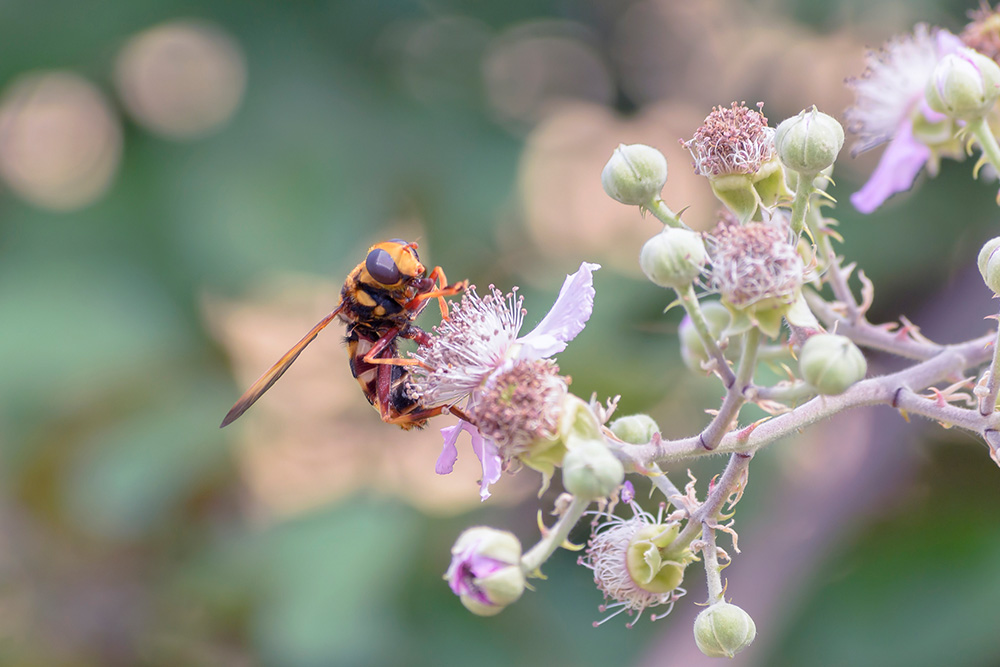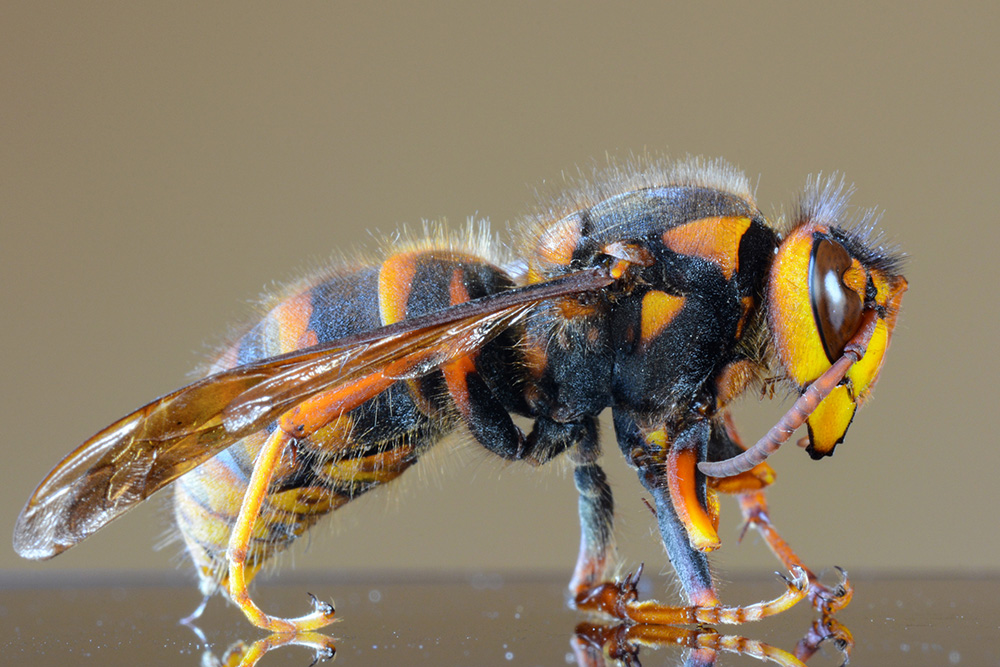Over the last few weeks you may have seen some headlines about Asian hornets being spotted in the USA for the first time – but with everything going on at the moment, it went in one ear and out the other, right?
I get it.
We are currently living in some crazy times, and as a result, looking outside your bubble can be hard to do.
But that does not mean you should not.
Especially when it comes to this.
What are Asian giant hornets?
 Asian giant hornets are exactly what they sound like – big nasty hornets.
Asian giant hornets are exactly what they sound like – big nasty hornets.
These Asian hornets (also known as the Vespa mandarinia) are about two inches long, have a bright orange head, are covered in bright orange stripes, and have an enormous curved stinger hanging off their rear end.
Oh, and I should probably mention that they are affectionally known as murder hornets.
Yeah, not so pleasant.
These hornets are found natively in forests and mountainous regions of eastern and south-eastern Asia. They are commonly found in places like Japan and South Korea (where they happen to kill about 50 people per year).
And now they are here in the US.
How did they make it into the US and where are they?
Where are Asian giant hornets?
As far as the Asian hornet’s invasion of US soil goes, it is still very early days.
The Washington State Department of Agriculture (WSDA) verified two sightings of Asian giant hornets in December last year (2019) in the city of Blaine. Apparently, they then received two more accounts describing the invasive insects in April 2020, but those remain unconfirmed.
As a result, there have been no confirmed sightings outside of Washington at this stage in time.
No one truly knows how these nasty little guys got here, but there are a couple of very likely scenarios. There is a genuine possibility that they were deliberately released or transported here as unseen stowaways in international cargo.
I like to imagine that the latter option is how they arrived, because thinking about someone deliberately bringing them into the country makes my blood boil.
How are they a danger to humans?
Earlier in this article I alluded to the fact that murder hornets are venomous, and in some situations, can even be deadly.
They are so large that they can sting you through fabric as thick as a beekeeper suit. Moreover, each hornet can sting multiple times, which is when you start to see some issues.
Fatalities from the giant hornet’s venom are typically the result of either anaphylactic shock or the onset of a heart attack. However, it is also important to note that deaths have occurred because of multiple organ failure, often after many stings.
Typical advice is that if you are stung more than 10 times, you should seek medical attention immediately. If you are stung more than 30 times, then emergency medical treatment will be required.
It is also important to note that the stings can cause kidney failure, and in times of large outbreaks, you can expect to see many hospitalizations in the area.
Finally, it is quite common for those stung by a hornet to show signs of skin bleeding, and even necrosis.
They really are a nasty insect.
Bur that is not the only thing you need to worry about…
How they are a danger to our bees?
While the impact that the murder hornets on our human population is far from pleasant, it is the impact they have on our bees that is a major concern.
When these murder hornets come across honeybees, they start to attack – and it is far from pretty.
Their attack starts with what is affectionally known as a “slaughter phase.” It is here where a group of hornets will start to attack a hive of honeybees by biting off their heads with their large and incredibly powerful mandibles.
Within 90 minutes, a small group of Asian hornets can destroy an entire colony of 25,000 bees.
But it does not stop there.
After the slaughter phase, they move onto feeding. This is where they occupy the honeybee nest for around a week, feeding on the pupae and larvae left behind by the honeybees. It is during this time where they also feed their own young, increasing the strength of the group.
It is a catastrophe.
Importance of bees for food supply
 The reason I use the word catastrophe is very deliberate.
The reason I use the word catastrophe is very deliberate.
You see, bees are known as pollinators. This is because here in the USA they pollinate over a third of our food supply, and a whopping 90% of our wild plants. This is important because pollination is required for the reproduction of many of the plants that make up our agriculture industry.
In fact, bees are so essential to crop pollination that some farmers even “rent” them out during the spring.
Unfortunately, over 25% of the honeybee population here in the USA has disappeared since 1990. And if they continue to disappear or die in rapid numbers, then our nations agricultural food supply will decrease.
If left unchecked, this has the capacity to lead to sustained increases in food cost, and a reduction in the availability of high-quality nutritious food across the country.
Related Article: The Three B’s of Farming: Bees, Butterflies, and Beetles
Course of action to control the hornets
The US department of agriculture have outlined two rather helpful approaches to controlling the spread of the Asian hornet – and they both rely on the application of certain chemical to aid in their eradication.
- Fast knockdown sprays that are immediately lethal, and
- Slower acting residual formulations designed to be spread among nest mates.
Fast knockdown sprays kill hornets on contact. This is beneficial to those who must approach the nest to apply the chemical. However, those hornets within the nest are less likely to be killed.
Conversely, slower acting chemicals are provided in the form of dust or foam. These chemicals attach to the hornets, who then carry them inside of the nest, exposing the entire colony to the formula. These are generally the most effective option.
A list of viable pesticides has been provided by the US Department of Agriculture and can be found on their website.
How to identify the hornet?
So, what do Asian giant hornets look like, and how can you identify them?
In short, giant Asian hornets can be identified by:
- Their velvety dark brown mid-section
- Their dark black head with a bright orange or yellow face
- The brown segments on the rear end, which are bordered with a fine yellow band
- Their dark brown upper leg segment, with their yellow lower leg segments
They are the only hornet or wasp that has an entirely dark brown or black velvety body, which is bordered by a yellow band – so if you do see a large hornet that fits that description, you can be pretty sure it is an Asian hornet.
Tips to stay safe if you see the hornet
First and foremost, if you do see an Asian hornet, I would like to encourage you to try and email a photograph of the insect to the Department of Entomology Insect Identification Laboratory.
This is a key step in stopping the spread of these nasty insects across the country.
Then if you do happen to disturb a hornet or its nest, crouch down low, stop moving, and cover your head. Hornets are intrigued by moving targets and consider running a provocation.
From here, try and shuffle away very slowly.
If a hornet does actually land on you, try not to panic. Do your best to gently brush it off and walk away calmly. Like running, panic and sudden movements is often considered provocative.
Now, if you do get stung once or twice, make sure to wash the area with soap and water as soon as you can. Then apply ice to keep down the swelling and inflammation. Swelling can last up to a week, and ibuprofen can help ease any soreness.
If the sting becomes increasingly inflamed, red, or warm to the touch, it could be a sign of infection. In this scenario, head to your local GP immediately.
Finally, if you do get stung multiple times, seek medical attention immediately.
Take Home Message
The landing of giant Asian hornets on US soil could spell disaster for our honeybee population. This, in turn, could have terrible effects on our nations agriculture industry, and our food supply.
This is something that we cannot let happen.
It is up to us to try and stop the spread of these nasty insects before it is too late. If you happen to spot one out in the wild, implement the steps outlined in this article to try and get them identified and eradicated.
And of course, make sure to look after yourself in the process.
Related Article: Stop Exporting Food to China, Bring It Back to the US



Add Comment